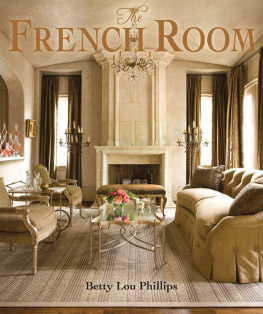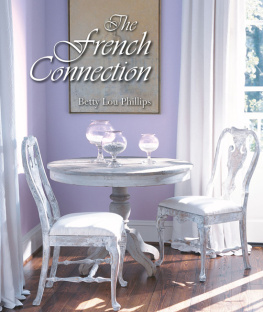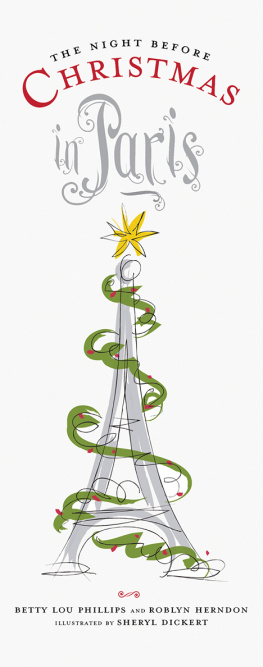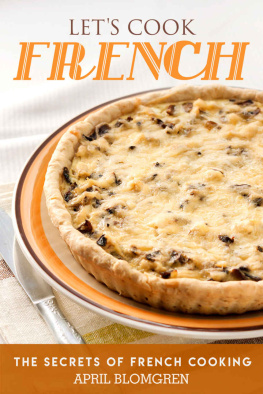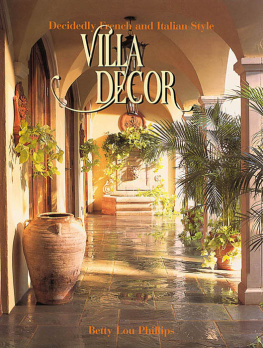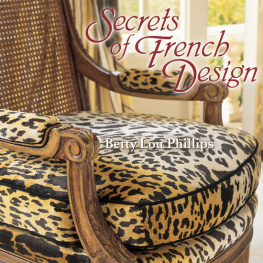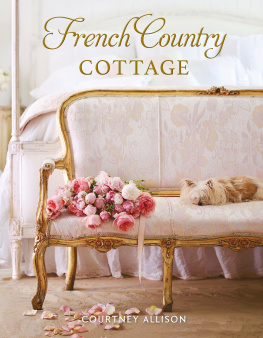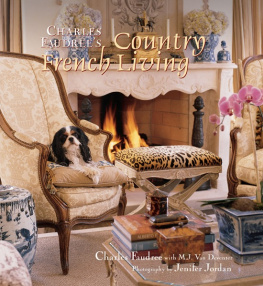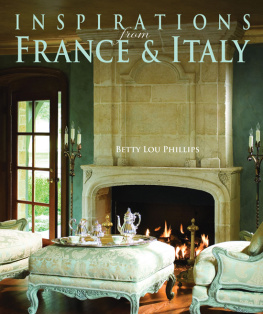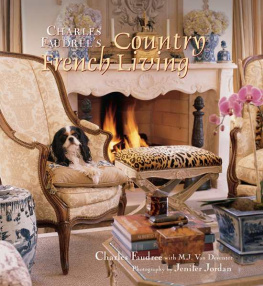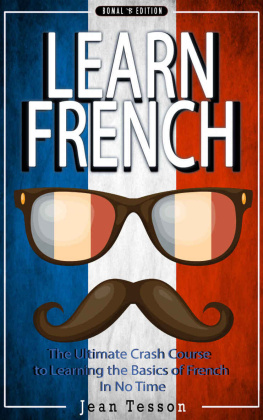All rights reserved. No part of this book may be reproduced by any means whatsoever without written permission from the publisher, except brief portions quoted for purpose of review.
Acknowledgments
To simply say thank you hardly seems adequate, but I would like to warmly thank the many people who helped air-lift The French Room and its 200 images to press. For without their help, this book would not be.
Special thanks, therefore, goes to those who opened the doors to their splendid chteaux and permitted us to photograph their residences: Heather and Bill Esping, Lisa and David Faulkner, Ruth and Jack Gay, Francie Faudree Gillman and Dale Gillman, Staci and Jeff Mankoff, Marsha and Bill Rickett, Lisa and Jay Ryan, Chris and George Tamke, Radonna and John Vollmer, Cathy and Jeff Wood and more.
I appreciate, too, the distinctive way of defining stylewith a chic blend of the traditional and edgyof the following designers: Laura Lee Clark Falconer, Sydney Fiedler, Francie Faudree Gillman and Dale Gillman, Sarah Lander Hast, Richard Gordon, Bill Hendrix, Pam Pierce, Carol Ray and Marlene Weitman, Lisa Luby Ryan and Liz Lank Williamson.
Also, I am personally grateful to those who worked overtime so our own projects could become an integral part of this book: Price Avent, Susan Brown, Donna Burley, Nancy Caperton, Buffy Cornell, Mark Danuser, James Davis, Esther Gandal, Lupe Hayes, Jennifer Howell, Bill Lawrence, Harold Leidner, Jesus Marroquin, Shaun Christopher Marshall, Carl McGowan, Philip Minton, Jodie Newby, Jim Palmer, Allan Rodewald, Corinthia Runge, Julia Rider, Jimmy Saunders, Clair Story and Linda Swain. Thanks also go to Jennifer Chapman, Julia Foster, Christy Gatchell, Angela Malone, Gillian Bradshaw Smith, Clair Storey, Jayne Taylor, Doreen Wallace and Julie Willenbrock.
For her prized design assistance, I thank Andrea Smith time and again. Together we thank our design-savvy team: Julie Macatee, Brenda Lyle, Katie Lang and Janice Stuerzl.
Add to the above list a love and appreciation for photographer Dan Piassick, book designer extraordinaire Cherie Hanson, and my longtime editor Madge Bairdeach helped polish The French Room to a gleam.

A comfortable haven works not only for entertaining friends but also for everyday life, thanks to a cozy palette and a mix of old and newgiving the impression that furnishings were gathered over time.

Understated elegance reigns in an entry with ample historical references. The painted settee, a marquise (a wide, low-back bergre capable of accommodating two people that became the prototype for the loveseat) and marble table are all old, the latter unearthed at Kay OToole Antiques in Houston. The leopard runner is from Stark Carpet. In seventeenth-century French chteaux, staircases swept to the rightensuring that right-handed men defending the estate from the top of the stairs could comfortably swing their swords to the right. Testaments to this architectural ideal continue today.
Introduction
The real voyage of discovery consists not in seeking new landscapes, but in having new eyes.
Marcel Proust
Given their strong sense of self, commanding flair and ardor for collecting, to say nothing of their savoir-faire, the French simply do not understand American dependence on decorators, which they view as leaving one vulnerable to uncertain results.
Its not that none would ever dream of collaborating with a design professional, only that most would never turn over control of a project even to the most capable hands. Never mind that ancestral furniture and objets dart conspire to make seeking expert help unnecessary. Most see decorating as an aesthetic undertaking en route to self-satisfaction.
So, what if faced with myriad issues that warrant assistance? In that case, the French are likely to have a comprehensive plan, opt to be hands-on and be precise in requestsspecifying styles, shapes and proportions in such detail that leaves little doubt about their wishes and suggests the confidence they have in their own good taste. Further ensuring the results are in keeping with the preciseness of their visions, many continue buying what they admire, upholding the exacting standards they insist upon. While adding to a trove of distinctive-looking family pieces, like-minded style setters paint flattering self-portraits revealing their creativity, interests and national pridewhich is, of course, their intention.
Without fail, settings start with furnishings handed down from one generation to the next. As rooms take shape, they gather even more accoutrements that are meaningful. Determined to prevent their heritage from fleeing to far-flung cities outside France as much as striving to make stylish statements, habitus flock to the Htel Drouot, in Pariss ninth arrondissement, or district, where more than 2,000 auctions held annually teem with temptations for every predilection.
In addition they spend weekends relentlessly combing the famed March aux Puces de Saint-Ouen, the vast flea market in existence since 1886 on the outskirts of the capital, unless scouring les puces (flea markets) at Vanves and Montreuil or traipsing to LIsle-sur-la-Sorgue, the Lubrons matchless center for antiques, with more than 250 brocanteurs (dealers in second-hand goods).
Even so, most interiors are neither cluttered nor intimidating. Despite the grandeur in which Louis XIV (16431715) and his descendants Louis XV (1715-74) and Louis XVI (177493) lived in the ostentatious Chteau de Versailleswith its approximately 700 rooms and 2,000 windowsunderstated beauty is a design dictum. The French equate elegance with restraint, shunning the wanton excess identified with the ousted ancien rgime.
Ongoing sympathies to the principles that led to the storming of the Bastille prison on July 14, 1789, and overthrow of a monarchy born in 987 cut across regions and class lines in this nation of more than 60 million people. Unlike in the United States, where there is more than a hint of elitism as even in an uncertain economy a record number of men and women are making fortunes and reveling in spending them on everything from high-performance cars to higher-performance airplanes to posh vacation homes in enclaves such as Aspen and the Hamptons, image-conscious Gaullists are wary of splurging on anything that might telegraph wealth. Rather, people of all economic levels link well-being with

